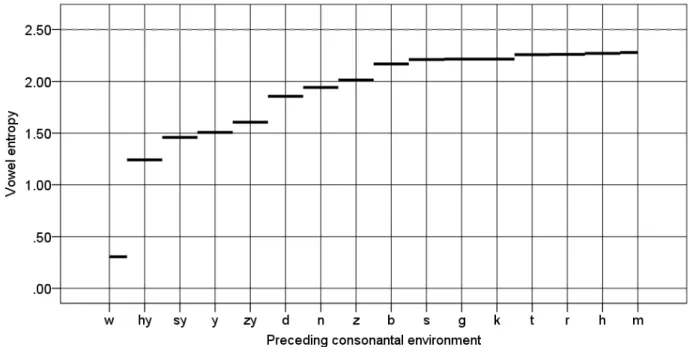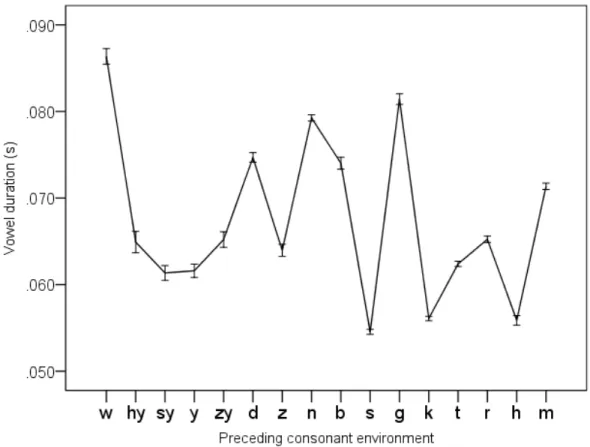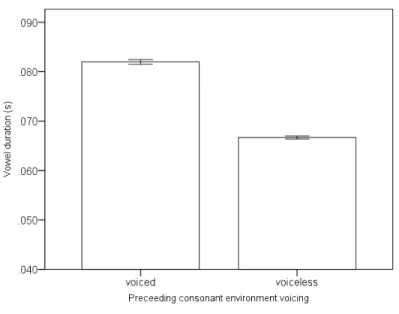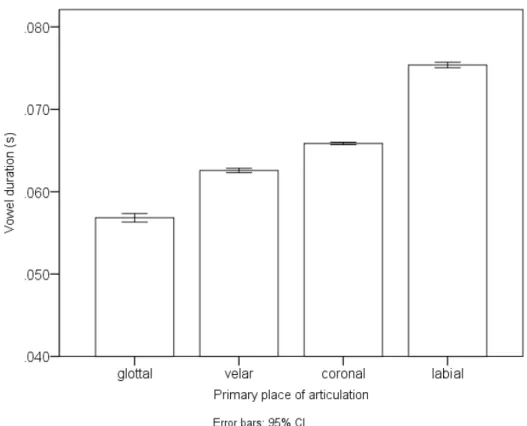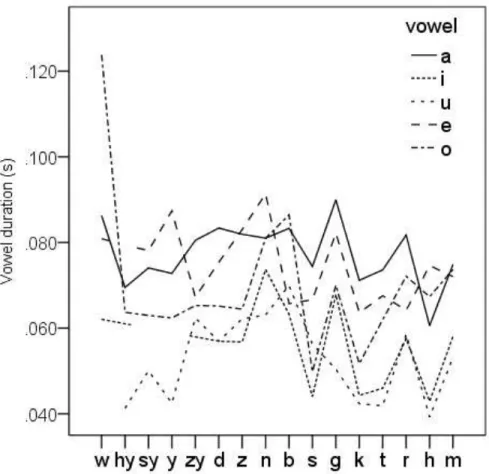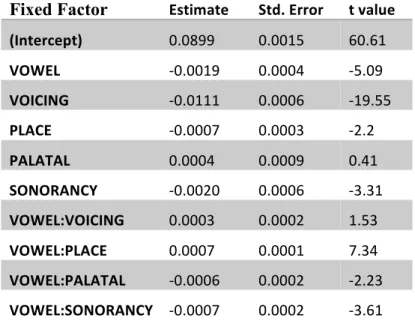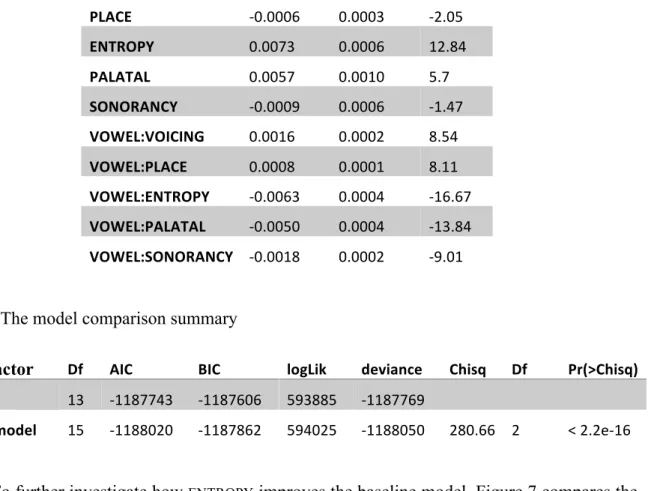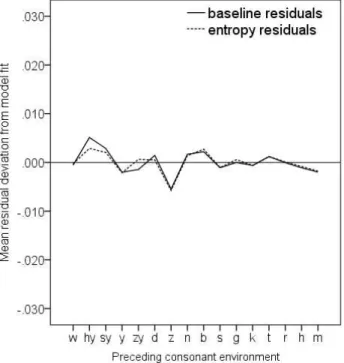Effects of vowel informativity on vowel duration in Japanese
KAWAHARA, Shigeto (Keio University)
SHAW, Jason (Western Sydney University/ Keio University)
Abstract
Research on English has shown that vowels that contain more information tend to be longer (Aylett & Turk 2004). This research is evolving into a general thesis that speakers articulate a segment with more information more robustly. While this hypothesis seems plausible from the perspective of communicative efficiency, previous support for it has come mainly from English. The current study thus examines this hypothesis in Japanese, using the Corpus of Spontaneous Japanese (the CSJ). Consonant-conditioned Shannon’s entropies were calculated, and their effects on vowel duration examined, together with other linguistic factors that are known from previous research to affect vowel duration. In addition to finding several linguistic factors affecting vowel duration, the current study reveals rather complex effects of informativity on vowel duration in Japanese.
Keywords: informativity, vowel duration, a corpus study, mora-timing, Japanese
1. Introduction
Recent phonetic research has shown that informativity can affect the duration of segments, syllables and words (e.g. Aylett and Turk, 2004, 2006, Bell et al., 2009, Cohen-Priva, 2012, 2015). This research is evolving into a general hypothesis that speakers may articulate a segment with more information more robustly—henceforth, we call this hypothesis the “informativity hypothesis”. The informativity hypothesis seems to be plausible from a viewpoint of efficient communication (Hume 2016): a segment that carries high information should not be misperceived by the listener; on the other hand, segments that can be predicted from contextual information—those with inherently low information—can be recovered by listeners, even if the signals are degraded. Indeed, recent research shows that this principle may be at work in governing several aspects of our phonetic behaviour. However, previous support for the informativity hypothesis has come mainly from English. The principle that the signal is controlled to maximize communicative efficiency should apply in principle to any language, and thus needs to be tested in languages other than English.
This paper assesses the informativity hypothesis by testing whether Japanese vowel duration is influenced by informativity (quantified as average “contextual predictability”), just like English. Japanese provides an interesting test case for the informativity hypothesis, since it differs rhythmically from English and uses duration to express phonological contrast extensively (Han 1962, Homma 1981 et seq.). Japanese is also known to be a “mora-timed” language (e.g.; Han 1962, 1994; Port et al. 1987; cf. Beckman 1982; see Warner and Arai 2001 for a review), in which the duration of each CV mora is more or less—though not perfectly—kept isochronous. For example, it is known that the same vowel is longer after a short consonant than after a long consonant, and this observation has been taken as evidence that Japanese speakers keep the
duration of CV unit more constant than otherwise (e.g. Homma 1980; Port et al. 1980; Sagisaka
& Tohkura 1984). Port et al. (1987) found a linear correlation between the word duration and the number of moras that the word contains. Given this mora-timing nature, it would be interesting to test whether Japanese vowels are longer when they are more informative, just like in English.
To address the informativity hypothesis, the current study computed informativity as the conditional entropy of a vowel given the preceding consonant and tested whether informativity affects vowel duration. This study also examined various other factors—vowel quality, preceding consonantal features, and others—which have been previously found to affect vowel duration in Japanese. This analysis addresses if and how entropy affects vowel’s duration beyond these potentially confounding factors.
2. Method: Vowel entropy by preceding consonant environment
The analysis is based on the Corpus of Spontaneous Japanese (Maekawa et al. 2000), one of the largest annotated speech corpora in Japanese. The analysis used the core portion of the corpus (known as the CSJ-RDB), which comes with rich annotation and phonetic information. The CSJ- RDB consists of the 11,559 unique words produced by 70 speakers, and over 312,000 vowel tokens. Following recent work (e.g. Cohen Priva 2012, 2015, Hall 2009, Hume 2016, Kawahara 2016), the current study deployed Shannon’s (1948) entropy to quantify informativity. Vowel entropy is defined as the weighted average of the surprisal of each vowel. The surprisal term is
−log%�(�). The surprisal term is multiplied by the probability of a vowel, � � . Vowel entropy,
� � , was calculated over the five Japanese vowels, /a/, /e/, /i/, /o/, /u/, in each consonantal environment in the corpus (� � = − /∈1� � ∗ log%� � ). The higher the entropy, the less predictable the vowel is, and the more informative that vowel is (Shannon 1948). Japanese has
phonotactic restrictions that reduce the number of vowels that can follow certain consonants and this influences informativity. For example, since front vowels are prohibited after palatalized consonants, it easier to predict vowel quality, either /a/, /u/, or /o/, in these environments. In these cases, entropy is low. On the other hand, the distribution of the five vowels can be unpredictable given a preceding consonant, in which case that vowel is very informative and its entropy is high. Given these considerations, the informativity hypothesis predicts a positive correlation between vowel entropy and vowel duration. Duration values are based on those provided in the CSJ-RDB.
3. Results
3.1. Vowel entropy by preceding consonant environment
Figure 1 shows how the entropy of vowels varies across consonantal environments. We have excluded marginal consonants that are under-represented in the corpus, showing only consonant environments with at least 1,000 occurrences in the corpus. The vertical axis represents entropy. Consonant environments, shown on the horizontal axis, are ordered from low to high entropy. The theoretical maximum of entropy given 5 vowels is 2.32 (−log%�(0.2)), which happens when all 5 vowels appear with the same probability (1/5=0.2). The solid black line indicates the entropy of the vowel in each consonantal environment in Japanese. The consonantal environment that conditions the highest vowel entropy is /m/, which is close to the theoretical maximum. There are several other consonants, e.g., /h/, /r/, /t/, /k/, /g/, /s/, with comparably high entropy. At the left side of figure, we find the consonant environments that condition low entropy. The consonant environment with the lowest entropy, /w/, is almost always followed by /a/, except in some loanwords like [wisukii] ‘whisky’. Thus, /w/, is a near perfect predictor of following vowel quality. Since the vowel following /w/ is highly predictable, it carries little information content, and its entropy is near zero. In between low entropy /w/ and the group of high entropy
consonants there is a roughly linear increase across the various palatal consonants, /hy/, /sy/, /y/, /zy/, and then voiced coronals, /d/, /n/, /z/.
Figure 1: The vowel entropy depending on the preceding consonants, ordered from low to high. [Xy] represents a palatalized version of X, the convention used in the CSJ.
Overall, Figure 1 indicates that there is substantial range in vowel entropy as a function of the preceding consonant environment. This variation allows us to assess whether vowel entropy affects vowel duration.
3.2. Vowel duration for each vowel
Figure 2 shows the distribution of vowel duration for each of the five Japanese vowels in the corpus. Phonemically long vowels were excluded (n=23,029) as were phonemically short vowels that were extreme outliers (+/- 3 SD from mean) in duration (n=3,714). After these exclusions,
286,057 tokens remained in the analysis. The shape of the distributions for each of the 5 vowels is similar: all have long right tails and steeper left tails that fall towards zero.
Figure 2: The distribution of vowel duration for each vowel.
Table 1 provides descriptive statistics for vowel duration by vowel. The mean duration of the five vowels follow the order of /a/ > /e/ > /o/ > /i/ > /u/, which is compatible with what is found in the previous studies on Japanese duration (Campbell 1992, 1999; Han 1962; Sagisaka & Tohkura 1984)—we take this replication as evidence that our data source, the CSJ, is reliable. The SD of vowel duration is rather high. For the high vowels, /i/ and /u/, the standard deviation is greater than half the mean.
3.3. Vowel duration in different consonantal environments
Figure 3 illustrates how vowel duration (y-axis) changes as vowel entropy (x-axis) increases. At first sight, there may not seem to be a correlation between the two measures. However, upon
Mean SD N
/a/ 78 31 80,589
/e/ 70 34 42,603
/o/ 67 32 72,477
/i/ 54 30 45,475
/u/ 52 29 44,913
total 63 33 286,057
Table 1. The number of valid token counts along with the mean and SD in ms. of the five vowels in Japanese.
careful examination, we observe other factors affecting vowel durations in Figure 3. So let us first filter out these effects. First, we consider /w/. It has the lowest entropy and is hence expected to show the shortest vowel duration according to the informativity hypothesis, but /w/ is almost always followed by /a/, which is inherently long (see Figure 2 and Table 1). Second, as shown in Figure 4, vowels are longer after voiced stops than after voiceless stops (compare /t/ vs. /d/ and /k/ vs. /g/).1 This effect has been found in lab speech obtained in previous production experiments, and an often given explanation is that since voiced stops are shorter, the following vowels are longer due to mora-timing (Port et al. 1980; Sagisaka & Tohkura 1984).
Figure 3: Vowel duration, ordered from low to high entropy.
1 Japanese has lost /p/ in its history, and therefore (singleton) /p/ only appears in loanwords and is thus rare in the overall Japanese lexicon (Ito and Mester 1995). This is why /p/ does not enter into the current analysis.
Figure 4: The average vowel duration after voiced (including both voiced obstruents and sonorants) and voiceless consonants.
We also observe an effect of place of articulation. Compare for example /m, b/ on the one hand, and /k/ on the other in Figure 3; it seems that vowels tend to be longer when following labial consonants than when followed by dorsal consonants. The effect of place of articulation is shown in Figure 5. It actually shows that a vowel that is preceded by a more front consonant is longer.
Figure 5. The average vowel duration after consonants with different primary place of articulation.
Another interesting effect has emerged when we analyze the duration pattern broken down by each vowel, as in Figure 6. Vowels are longer when they share an articulator with the following consonant. Comparing vowels following /g/ vs. /b/, /u/ and /o/—vowels involving some control of the lips—are longer after /b/ than after /g/; /a/ and /e/—vowels involving the positioning of the tongue body—are longer after /g/ than after /b/; in contrast, /i/, which involves palatal approximation by the tongue blade, is similar across /b/ and /g/.
Figure 6: Vowel duration after different preceding consonants, broken by vowel types.
The above observations (Figures 4-6) show that, in order to evaluate the effect of vowel information on duration, we need to take other effects into account. To that end, we fit two generalized linear models to the data. One is the baseline model, which involves segmental factors that condition following vowel duration, including those presented above. The other one adds entropy as an additional predictor. A comparison between these two models allows us to assess the effect of vowel entropy in the presence of other factors that known to influence vowel duration.
3.4. The model comparison
The baseline model contained the following fixed factors: VOWEL quality (a, i, u, e, o), VOICING
(voiced vs. voiceless), primary PLACE of articulation (glottal, coronal, labial, velar), PALATAL
(non-palatal vs. palatal), and SONORANCY (sonorant vs. obstruent). Each of these fixed factors was dummy coded with the first level as the reference category: /a/ for VOWEL QUALITY; voiced consonants for VOICING; glottal consonants, /h/ and /hy/, for PLACE of articulation; non-palatal consonants for the PALATAL factor; and sonorants, /w/, /y/, /n/, /r/, /m/, for the SONORANCY factor. All interactions between these factors and VOWEL quality were also included in the baseline model. We also included random intercepts for talker and for word. Table 2 provides a summary of the fixed factors in the baseline model; Table 3 summarizes the Entropy model. Both models were fit to 280,550 data points (see the method section).
We start with a description of the baseline model. The intercept represents an abstract reference category (/a/ before consonants that are voiced, glottal, non-palatal, sonorant). At 89.9 ms, the intercept is higher than the average vowel duration in the data (Table 1). Accordingly, most of the fixed factors are negative, functioning to lower predictions relative to the intercept. The effect of VOWEL is small but reliable. It is in a negative direction, reflecting the observation that the non-intercept vowels, /i/, /u/, /e/, /o/, are shorter than /a/. The effect of VOICING, at 11.1 ms, is comparatively large and uniform across vowels. The negative direction indicates that vowels are shorter when they follow voiceless consonants than when they follow voiced consonants (Figure 4). PLACE has a small but reliable effect and interacts significantly with
VOWEL. The main effect of PLACE is negative, indicating that vowels are shorter when following non-glottal consonants (dorsal, coronal, labial) but the interaction with VOWEL is positive. The significant positive interaction between PLACE and VOWEL indicates that, as observed in Figure 6,
the effect of PLACE varies across vowels. Although the main effect of PALATAL was not significant, the interaction between PALATAL and VOWEL was small but reliable. This interaction indicates that PALATAL has an effect on some vowels but not others. Finally, the main effect of
SONORANCY and the significant interaction between SONORANCY and VOWEL were both negative. This indicates that vowels following obstruents are always slightly shorter than vowels following sonorants but that the size of the effect varies across vowels. Overall, the baseline model provides estimates for fixed factors that are reasonable given the descriptions of the patterns above (e.g., Figures 2, 4- 6).
Incorporating ENTROPY and the interaction between ENTROPY and VOWEL results in significant improvement over the baseline model. Table 4 summarizes the model comparison. The lower Akaike Information Criterion (AIC) for the ENTROPY model indicates that the additional model complexity resulting from inclusion of ENTROPY and ENTROPY*VOWEL factors is justified by the increased log likelihood of the data. Both ENTROPY and the interaction between
ENTROPY and VOWEL are significant predictors in the model (Table 3). The presence of these factors also influences the estimates of other fixed factors, most notably: VOWEL, PALATAL,and
SONORANCY. This change occurs because ENTROPY explains some of the variance attributed to
VOWEL, PALATAL, and SONORANCY factors in the baseline model. Compared to the baseline model, the size of the negative effect of SONORANCY decreases while the interaction between
SONORANCY and VOWEL, also negative, increases. Thus, with entropy in the model, it becomes clearer that SONORANCY effects are vowel-specific. Additionally, with ENTROPY in the model, a significant main effect of PALATAL emerges and the size of the PALATAL*VOWEL estimate also increases. Alongside these changes in interaction terms comes a change in the direction of the
VOWEL estimate. In the entropy model, the VOWEL factor is no longer negative, as it is in the
baseline model. Rather, the VOWEL factor has a strong (11.5 ms), positive effect. This indicates that the longer average duration of /a/ observed in the corpus (Figure 2) can be fully attributed to the conditioning environments, including ENTROPY, in which the vowels occur. In other words, the entropy model suggests that /a/ is longer than the other vowels not because of some intrinsic difference in vowel duration but rather because of the distribution of /a/ in the corpus.2
Table 2: Baseline model: duration ~ vowel*voicing + vowel*place + vowel*palatal + vowel
*sonorancy+(1|talker)+(1|word)
Fixed Factor Estimate Std. Error t value (Intercept) 0.0899 0.0015 60.61
VOWEL -0.0019 0.0004 -5.09
VOICING -0.0111 0.0006 -19.55
PLACE -0.0007 0.0003 -2.2
PALATAL 0.0004 0.0009 0.41
SONORANCY -0.0020 0.0006 -3.31 VOWEL:VOICING 0.0003 0.0002 1.53 VOWEL:PLACE 0.0007 0.0001 7.34 VOWEL:PALATAL -0.0006 0.0002 -2.23 VOWEL:SONORANCY -0.0007 0.0002 -3.61
Table 3: Entropy model: duration ~ vowel*voicing + vowel*place + vowel*palatal + vowel
*sonorancy+vowel*entropy
Fixed Factor Estimate Std. Error t value (Intercept) 0.0746 0.0019 38.72
VOWEL 0.0115 0.0009 12.9
VOICING -0.0128 0.0006 -22.1
2 Cf. An oft-given statement to the effect that “[a] is long because it is an open vowel, and it takes time to open the mouth to complete the articulation of [a]”.
PLACE -0.0006 0.0003 -2.05
ENTROPY 0.0073 0.0006 12.84
PALATAL 0.0057 0.0010 5.7
SONORANCY -0.0009 0.0006 -1.47 VOWEL:VOICING 0.0016 0.0002 8.54 VOWEL:PLACE 0.0008 0.0001 8.11 VOWEL:ENTROPY -0.0063 0.0004 -16.67 VOWEL:PALATAL -0.0050 0.0004 -13.84 VOWEL:SONORANCY -0.0018 0.0002 -9.01
Table 4: The model comparison summary
Fixed Factor Df AIC BIC logLik deviance Chisq Df Pr(>Chisq) baseline 13 -1187743 -1187606 593885 -1187769
entropy model 15 -1188020 -1187862 594025 -1188050 280.66 2 < 2.2e-16
To further investigate how ENTROPY improves the baseline model, Figure 7 compares the residuals of the baseline model with the residuals of the entropy model across consonant environments. The vertical axis is set to ±30 ms, the approximate standard deviation of vowel duration across the corpus (see Table 1). The mean residual deviation stays well under a third of the standard deviation. For many consonantal environments, the residual deviation is less than 6 ms, which is roughly the degree of duration measurement error in acoustic data, i.e., one period of voicing in the waveform. Thus, overall, the models’ predictions are very good. The largest improvements of the entropy model over the baseline model comes for the palatalized consonants [hy], [sy], and [zy], which gradually increase in entropy (see Figure 1). For [hy] and [sy], the baseline model underestimates the duration of vowels, leading to positive residuals; for [zy] the baseline model overestimates duration, leading to negative residuals. The entropy factor increases the predicted duration of lower entropy [hy] and [sy] and decreases the predicted
duration of higher entropy [zy], bringing all three predictions closer to the data. The observation in Figure 7 that ENTROPY improves predictions primarily in palatal environments relates to the change in coefficient estimate for PALATAL across baseline and entropy models. Palatal consonants in Japanese are rarely followed by front vowels, /i/ and /e/, which is what makes them a low entropy environment. Vowels following palatalized consonants tend to be longer on average than vowels following non-palatal counterparts (compare contexts /sy/ vs. /s/, /zy/ vs. /z/, and /hy/ vs. /h/ in Figure 2); however, the size of the effect varies across these comparisons consonants—it is largest for /hy/ vs. /h/, followed by /sy/ vs. /s/ and then /zy/ vs. /z/. Thus, the size of the effect of PALATAL on vowel duration decreases with increasing entropy. Lacking
ENTROPY as a factor, the baseline model did not have a means to capture this pattern.
Figure 7: Comparison of the residuals of the baseline model and those of the entropy model.
Above all, the ENTROPY factor in the model has a positive effect, which may seem to support the informativity hypothesis. However, the interaction term, ENTROPY*VOWEL, was
negative. This interaction indicates that the effect of ENTROPY on vowel duration is not uniform across vowels. Besides ENTROPY, other factors interacted significantly with VOWEL as well. To probe these interactions in greater depth, we fit the full entropy model to each vowel separately. Table 5 summarizes the models. Across vowels, the effect of consonant voicing was always in the same direction. The negative β estimate indicates that vowels are shorter when following voiceless consonants than when following voiced consonants. The size of the effect, however, differs across vowels, ranging from 7.9 ms (for /o/) to 13 ms (for /u/). PLACE of articulation showed smaller effects, ranging from -0.5 ms (for /o/) to 5 ms (for a). PALATAL had a large (22 ms) shortening effect on /o/ and a lengthening effect (15 ms) on /u/. SONORANCY was significant for /a/, /i/ and /o/. It had a positive effect on /a/, meaning that /a/ is slightly longer following obstruents than sonorants and a negative effect on /i/ and /o/. Finally, the effect of ENTROPY also varied across vowels in both size and direction. There were significant positive effects of
ENTROPY on /u/ (18.3 ms) and /a/ (7.2 ms) and negative effects of ENTROPY on /i/ (-11.0 ms) and /o/ (-27.2 ms). The effect of ENTROPY on /e/ was small and not statistically reliable.
/a/ /i/ /u/ /e/ /o/
Fixed Factor β t value β t value β t value β t value β t value
(Intercept) 0.0608 31.65 0.1060 16.07 0.0261 2.38 0.0977 13.47 0.1584 31.65
VOICING -0.0082 -14.75 -0.0098 -9.90 -0.0132 -17.87 -0.0091 -8.34 -0.0079 -9.48
PLACE 0.0050 14.64 -0.0008 -1.77 0.0029 7.80 -0.0031 -4.77 -0.0005 -1.26
ENTROPY 0.0072 17.36 -0.0110 -3.67 0.0183 3.90 -0.0031 -1.04 -0.0272 -11.79
PALATAL 0.0005 0.58 NA NA 0.0159 4.69 -0.0042 -0.98 -0.0222 -12.44
SONORANCY 0.0019 2.95 -0.0071 -7.37 0.0001 0.14 -0.0006 -0.53 -0.0117 -14.56
Table 5: β estimates and t values for fixed factors in mixed models fit separately to each vowel.
4. Discussion
To summarize the results, we found that entropy has a significant effect on vowel duration. The improvement of the entropy model over the baseline model is largely attributable to how entropy improves predictions for vowels following palatalized consonants, where front vowels are prohibited. As the contextual uncertainty of the vowel increases, /a/ and particularly /u/ show increased duration.
On the front vowels, ENTROPY had either no effect, i.e. for /e/, or the opposite (anti- informativity) effect, i.e., for /i/. This may be because front vowels have other ways to signal their presence besides lengthening. The front vowels, /i/ in particular, have strong coarticulatory influences on preceding consonants (Okada 1999: 118). Although beyond the scope of our current inquiry, it may be that the degree to which front vowels influence the articulation of preceding consonants is conditioned by entropy. We make the cursory observation that consonants with increasing entropy tend to be those that are more susceptible to coarticulation effects of /i/ (i.e., low coarticulatory resistance). Coarticulation may have a similar influence on increasing phonetic redundancy as lengthening the vowel. Palatalized consonants, where we see effects of entropy on vowel duration, exhibit a high degree of coarticulatory resistance (e.g. Recasens and Espinosa 2009). It seems then, that vowel duration adjustment as a function of informativity places a significant role in a non-arbitrary subset of the Japanese phonological system.
The negative effect of ENTROPY on /o/ duration also requires comment. Amongst the five Japanese vowels, /o/ occurs as a long vowel far more frequently than the other vowels. In the CSJ corpus investigated here, /o:/ occurs in 1872 unique words compared with just 941 for /e:/, 599 for /u:/, 432 for /i:/, and 421 for /a:/. Given the likelihood of long /o:/, short /o/ may resist
lengthening in response to informativity. As vowel uncertainty increases, it may become more important for short /o/ to maintain perceptual distinctiveness from /o:/ than from the other Japanese vowels. Reducing the duration of short vowels in high entropy environments would be one way to do this. The essence of this explanation is that when speakers are uncertain about vowel quality, they start caring about the length contrast as well, especially if the long competitor is frequent. This prediction can be tested in other languages that have a length contrast on vowels.
We would like to close this section with one methodological remark. Previous work on the informativity hypothesis cited in the introduction did not look at each segment separately. Recall that in the current work too, the overall effect of entropy was positive (Tables 3 and 4). Upon closer look, however, it turned out that the relationship between informativity and vowel duration is not as straightforward as it first appeared. This conclusion does not in and of itself deny the effect of informativity on segmental duration; we do believe that the informality principle is at work in Japanese. Overall, this study highlights the importance of looking at individual data, which may reveal the interplay of various principles that govern phonetic behaviour.
5. Conclusion
To conclude, the current analysis of the CSJ reveals that various factors affect vowel duration in Japanese. In addition to these effects, consonant-conditioned entropy affects vowel duration as well, which supports the informativity hypothesis, but its positive effect surfaces in limited environments. We offered some explanations for why vowel lengthening does not occur in certain high entropy environments; vowel lengthening may be prevented when the vowel length
contrast becomes important or when the preceding consonant is susceptible to coarticulation with the vowel, which can be used as a cue to the presence of that vowel.
References
Aylett, M., and A. Turk. 2004. The smooth signal redundancy hypothesis: A functional
explanation for relationships between redundancy, prosodic prominence, and duration in spontaneous speech. Language and Speech 47:31–56.
Aylett, M., and A. Turk. 2006. Language redundancy predicts syllabic duration and the spectral characteristics of vocalic syllable nuclei. JASA 119:3048–3059.
Beckman, M. 1982. Segmental duration and the ‘mora’ in Japanese. Phonetica 39. 113–135. Bell, A., J. M. Brenier, M. Gregory, C. Girand, and D. Jurafsky. 2009. Predictability effects on
durations of content and function words in conversational English. Journal of Memory and Language 60:91–111.
Campbell, N. 1992. Segmental elasticity and timing in Japanese. In Speech Perception,
Production and Linguistics Structure, eds. Y. Tohkura, E. V. Vatikiotis-Bateson and Y. Sagisaka, 403-418: Ohmsha.
Campbell, N.. 1999. A study of Japanese speech timing from the syllable perspective. Onsei Kenkyu [Journal of the Phonetic Society of Japan] 3(2): 29–39.
Cohen-Priva, U. 2012. Deriving linguistic generalizations from information utility. Doctoral dissertation, Stanford University.
Cohen-Priva, U. 2015. Informativity affects consonant duration and deletion rates. Journal of Laboratory Phonology 6: 243-278.
Han, M. 1962. The feature of duration in Japanese. Onsei on Kenkyuu [Studies in Phonetics] 10: 65-80.
Han, M. 1994. Acoustic manifestations of mora timing in Japanese. JASA 96. 73–82.
Hall, K-C. 2009. A probabilistic model of phonological relationships from contrast to allophony. Doctoral dissertation, Ohio State University.
Homma, Y. 1981. Durational relationship between Japanese stops and vowels. Journal of Phonetics 9. 273–281.
Hume, E.. 2016. Phonological markedness and its relation to the uncertainty of words. On-in Kenkyu [Phonological Studies] 19:107–116.
Ito, J., and A. Mester. 1995. Japanese phonology. In The handbook of phonological theory, ed. John Goldsmith, 817–838. Oxford: Blackwell.
Kawahara, S.. 2016. Japanese loanword devoicing once again: Insights from Information Theory. Proceedings of FAJL 8.
Maekawa, K., H. Koiso, S. Furui, and H. Isahara. 2000. Spontaneous speech corpus of Japanese. Proceedings of the Second International Conference of Language Resources and
Evaluation 947–952
Okada, Hideo (1999) Japanese. Tha Handbook of the Ineternational Phonetic Association : 117– 119.
Port, R., S. Al-Ani, and S. Maeda (1980) Temporal compensation and universal phonetics. JPhon 37: 235-252.
Port, R., J. Dalby and M. O’Dell. 1987. Evidence for mora timing in Japanese. JASA 81. 1574– 1585.
Recasens, D., & Espinosa, A. (2009). An articulatory investigation of lingual coarticulatory resistance and aggressiveness for consonants and vowels in Catalan. The Journal of the acoustical society of America, 125(4), 2288-2298.
Sagisaka, Y. and Y. Tohkura. 1984. Kisoku ni yoru onsei gōsei no tame no on’in jikanchō seigyo [Phoneme duration control for speech synthesis by rule]. Denshi Tsūshin Gakkai
Ronbunshi [The Transactions of the Institute of Electronics, Information and Communication Engineers A] 67(7). 629–636.
Shannon, C. 1948. A mathematical theory of communication. MA Thesis, MIT. Warner, N. and T. Arai. 1999. Japanese mora-timing: A review. Phonetica 58. 1–25.
